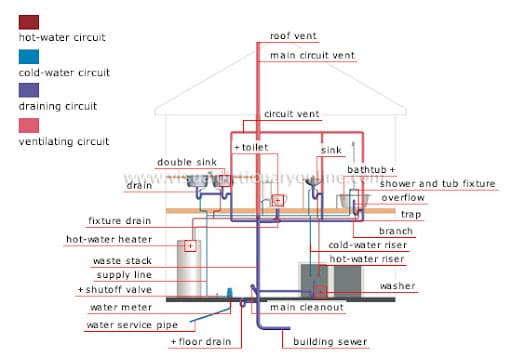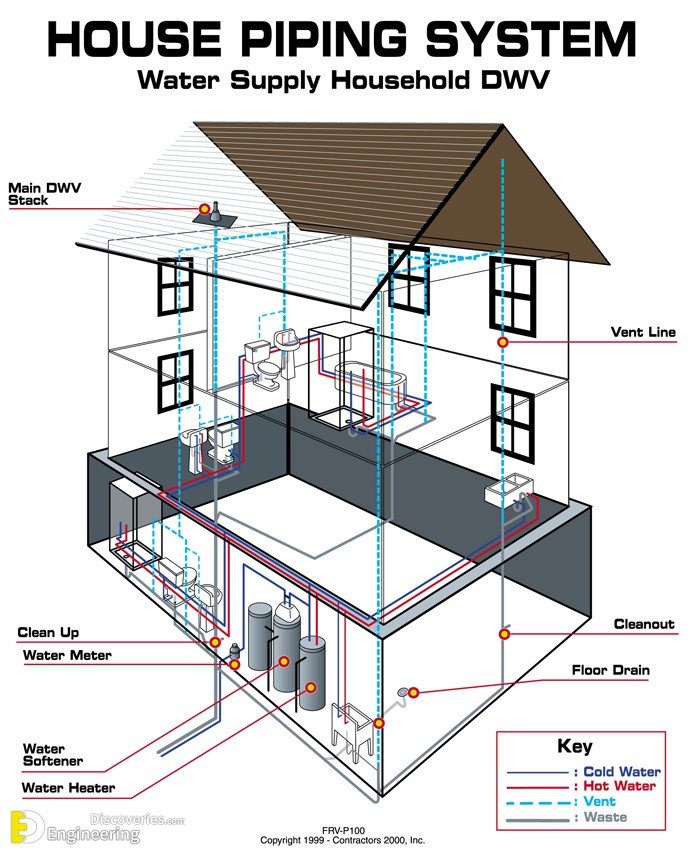Essential Parts of Your House's Plumbing System
Essential Parts of Your House's Plumbing System
Blog Article
We've noticed this post involving Anatomy of a House: Understanding the Components down the page on the web and concluded it made perfect sense to talk about it with you on my blog.

Understanding exactly how your home's pipes system works is vital for every single property owner. From providing tidy water for drinking, food preparation, and showering to securely getting rid of wastewater, a properly maintained plumbing system is crucial for your family members's health and wellness and convenience. In this thorough guide, we'll check out the complex network that composes your home's plumbing and deal pointers on maintenance, upgrades, and managing usual issues.
Intro
Your home's pipes system is more than just a network of pipelines; it's an intricate system that ensures you have accessibility to tidy water and efficient wastewater removal. Understanding its components and just how they work together can help you avoid expensive fixings and ensure everything runs smoothly.
Standard Elements of a Plumbing System
Pipelines and Tubing
At the heart of your plumbing system are the pipes and tubing that lug water throughout your home. These can be made from numerous materials such as copper, PVC, or PEX, each with its advantages in terms of toughness and cost-effectiveness.
Components: Sinks, Toilets, Showers, etc.
Fixtures like sinks, toilets, showers, and bath tubs are where water is made use of in your home. Comprehending just how these fixtures connect to the plumbing system aids in detecting troubles and intending upgrades.
Shutoffs and Shut-off Factors
Shutoffs regulate the circulation of water in your pipes system. Shut-off shutoffs are critical throughout emergency situations or when you need to make repairs, permitting you to separate parts of the system without interrupting water flow to the whole home.
Supply Of Water System
Key Water Line
The primary water line connects your home to the metropolitan water system or a personal well. It's where water enters your home and is dispersed to different fixtures.
Water Meter and Pressure Regulator
The water meter measures your water use, while a stress regulatory authority guarantees that water flows at a safe pressure throughout your home's pipes system, stopping damages to pipes and fixtures.
Cold Water vs. Warm water Lines
Comprehending the distinction in between cold water lines, which supply water directly from the major, and warm water lines, which carry heated water from the hot water heater, assists in fixing and planning for upgrades.
Water drainage System
Drain Pipes Pipeline and Traps
Drain pipes lug wastewater far from sinks, showers, and toilets to the sewage system or septic system. Traps stop sewer gases from entering your home and additionally trap particles that might cause obstructions.
Ventilation Pipes
Air flow pipes allow air right into the drainage system, stopping suction that can slow water drainage and cause catches to vacant. Appropriate air flow is crucial for preserving the honesty of your plumbing system.
Value of Proper Drain
Making certain appropriate drainage avoids back-ups and water damage. On a regular basis cleansing drains and preserving catches can prevent expensive fixings and extend the life of your plumbing system.
Water Furnace
Types of Water Heaters
Hot water heater can be tankless or traditional tank-style. Tankless heating units warmth water on demand, while tanks store heated water for prompt use.
Just How Water Heaters Attach to the Plumbing System
Recognizing how hot water heater connect to both the cold water supply and warm water circulation lines assists in detecting issues like inadequate hot water or leaks.
Upkeep Tips for Water Heaters
On a regular basis purging your water heater to eliminate debris, checking the temperature level setups, and examining for leakages can extend its life expectancy and boost power efficiency.
Typical Pipes Issues
Leakages and Their Causes
Leakages can take place due to aging pipelines, loosened fittings, or high water pressure. Attending to leaks immediately prevents water damages and mold growth.
Blockages and Obstructions
Obstructions in drains and commodes are often triggered by purging non-flushable things or a build-up of grease and hair. Utilizing drainpipe displays and bearing in mind what drops your drains can prevent blockages.
Indications of Plumbing Issues to Expect
Low water stress, sluggish drains pipes, foul odors, or abnormally high water costs are signs of potential plumbing problems that ought to be dealt with without delay.
Plumbing Maintenance Tips
Regular Evaluations and Checks
Set up yearly pipes examinations to capture concerns early. Look for signs of leaks, corrosion, or mineral buildup in faucets and showerheads.
DIY Maintenance Tasks
Simple tasks like cleaning tap aerators, looking for commode leakages making use of color tablet computers, or shielding revealed pipelines in cool environments can protect against significant pipes problems.
When to Call an Expert Plumbing Technician
Know when a pipes concern calls for expert proficiency. Attempting complicated repair work without appropriate knowledge can lead to more damages and greater repair service prices.
Updating Your Pipes System
Factors for Updating
Upgrading to water-efficient fixtures or changing old pipelines can enhance water high quality, lower water costs, and boost the value of your home.
Modern Plumbing Technologies and Their Advantages
Discover innovations like smart leakage detectors, water-saving toilets, and energy-efficient hot water heater that can save cash and decrease environmental effect.
Cost Factors To Consider and ROI
Calculate the ahead of time expenses versus lasting cost savings when taking into consideration plumbing upgrades. Several upgrades pay for themselves via decreased energy expenses and less repair work.
Ecological Impact and Preservation
Water-Saving Fixtures and Home Appliances
Mounting low-flow faucets, showerheads, and commodes can considerably lower water usage without giving up performance.
Tips for Minimizing Water Use
Simple routines like fixing leaks immediately, taking much shorter showers, and running full tons of laundry and meals can preserve water and lower your utility costs.
Eco-Friendly Plumbing Options
Think about lasting plumbing materials like bamboo for flooring, which is durable and green, or recycled glass for kitchen counters.
Emergency situation Preparedness
Steps to Take During a Plumbing Emergency situation
Know where your shut-off valves are located and how to turn off the supply of water in case of a ruptured pipeline or significant leakage.
Relevance of Having Emergency Situation Calls Handy
Maintain call info for regional plumbing technicians or emergency services easily offered for fast action throughout a pipes dilemma.
Do It Yourself Emergency Situation Fixes (When Suitable).
Short-lived solutions like utilizing air duct tape to spot a leaking pipe or putting a bucket under a trickling tap can decrease damages up until an expert plumbing professional gets here.
Verdict.
Comprehending the composition of your home's plumbing system equips you to maintain it effectively, conserving money and time on repair services. By complying with regular upkeep regimens and staying educated concerning contemporary plumbing technologies, you can ensure your pipes system runs effectively for many years ahead.
HOW YOUR PLUMBING SYSTEM WORKS
Which Pipes Do What?
Blue lines = fresh water supply entering the building
Red lines = hot water supply entering the building
Grey lines = pipes carrying waste away from the building and venting pipes carrying gases away from the building (through the roof)
YOUR MAIN PLUMBING SYSTEMS
There are two main plumbing systems that support your home s basic plumbing needs one that brings clean water into your home, and one that sends dirty water away from your home. Connected to the toilet, bath, shower, and other faucets in your home, these two systems keep your water flowing in the right directions.
ACCESSING FRESH WATER
Fresh and clean water is brought into your home through the main water supply line . Filtered through one pipe, this water is pressured to flow into the various fixtures in your home at any given time.
This water can be sourced from a well located on your property, a pond or river (mostly cottages), or, as in most cases, from the city s municipal water treatment centre. However, it is important to note that water that is untreated, such as the water siphoned from ponds or rivers, may not be safe to drink. Personal water supplies always need to be treated for hardness and contaminants before consumed.
MUNICIPAL WATER SUPPLIES
Improve taste and odour
Remove sediment
Eliminate hardness
Reduce chlorine
COLD WATER SUPPLY VS. HOT WATER SUPPLY
Cold water flows into your home or building through the service line, which then distributes hot or cold water to your fixtures. This line is most commonly run through a central column that runs floor to floor. Hot water runs in short and straight pipes as the longer the pipeline, the more heat that will be lost in the transfer. Having shorter pipes also allows residents to access hot water more quickly.
WASTE WATER SYSTEM
Your wastewater system is divided into two parts pipes that send wastewater away from your home and venting pipes that send sewer gas away from your home. Sewage water travels through pipes that flush the water and waste towards local sewers that are operated and managed by your city or town. Most sewer systems rely on gravity to move the wastewater to where it needs to go.
The further away from your toilet or sink, the larger wastewater pipes become. This allows for waste to be disposed of from various parts of your home or business at once without pipe blockages. The angle and flow of these pipes are also essential for keeping your waste pipes clear of build up.
https://harrisplumbing.ca/how-your-home-plumbing-system-works/

HOW YOUR PLUMBING SYSTEM WORKS
Which Pipes Do What?
YOUR MAIN PLUMBING SYSTEMS
There are two main plumbing systems that support your home s basic plumbing needs one that brings clean water into your home, and one that sends dirty water away from your home. Connected to the toilet, bath, shower, and other faucets in your home, these two systems keep your water flowing in the right directions.
ACCESSING FRESH WATER
Fresh and clean water is brought into your home through the main water supply line . Filtered through one pipe, this water is pressured to flow into the various fixtures in your home at any given time.
This water can be sourced from a well located on your property, a pond or river (mostly cottages), or, as in most cases, from the city s municipal water treatment centre. However, it is important to note that water that is untreated, such as the water siphoned from ponds or rivers, may not be safe to drink. Personal water supplies always need to be treated for hardness and contaminants before consumed.
MUNICIPAL WATER SUPPLIES
COLD WATER SUPPLY VS. HOT WATER SUPPLY
Cold water flows into your home or building through the service line, which then distributes hot or cold water to your fixtures. This line is most commonly run through a central column that runs floor to floor. Hot water runs in short and straight pipes as the longer the pipeline, the more heat that will be lost in the transfer. Having shorter pipes also allows residents to access hot water more quickly.
WASTE WATER SYSTEM
Your wastewater system is divided into two parts pipes that send wastewater away from your home and venting pipes that send sewer gas away from your home. Sewage water travels through pipes that flush the water and waste towards local sewers that are operated and managed by your city or town. Most sewer systems rely on gravity to move the wastewater to where it needs to go.
The further away from your toilet or sink, the larger wastewater pipes become. This allows for waste to be disposed of from various parts of your home or business at once without pipe blockages. The angle and flow of these pipes are also essential for keeping your waste pipes clear of build up.
https://harrisplumbing.ca/how-your-home-plumbing-system-works/
We were made aware of that write-up about from a good friend on our other blog. Liked our post? Please share it. Let others locate it. Thank you for going through it.
Click On This Link Report this page